These Adobo Chicken Wings have quickly become my family's favorite weekend treat. I discovered this recipe while exploring Filipino cuisine and fell in love with how the tangy soy sauce and vinegar marinade transforms ordinary chicken wings into something extraordinary.
The wings come out of the oven perfectly crispy on the outside while remaining juicy inside, and that sticky, flavorful glaze takes them to the next level. What I love most is how simple ingredients create such complex flavors, your guests will think you spent all day in the kitchen, but it's mostly hands-off marinating time doing the work.
Trust me, once you try these wings, traditional buffalo wings will take a backseat in your recipe collection.
What Are Adobo Chicken Wings?
Adobo Chicken Wings are inspired by the classic Filipino dish chicken adobo, a staple in Filipino cuisine. Traditional chicken adobo is made by simmering chicken in a mixture of soy sauce, vinegar, garlic, and spices.
This recipe takes that signature flavor profile and applies it to chicken wings, which are marinated, roasted until crispy, and then tossed in a reduced version of the marinade. The result is wings that are deeply flavored with the perfect balance of salty, tangy, and savory notes that characterize Filipino adobo cooking.
Jump to:
Why You'll Love This Recipe
These Adobo Chicken Wings bring the incredible umami-rich flavors of traditional Filipino chicken adobo to crispy oven-roasted wings. The marinade infuses deeply into the meat, creating wings that are flavorful to the bone with a perfect sticky, finger-licking glaze. This recipe combines the best of both worlds - the complex layering of Filipino adobo flavors with everyone's favorite party food, creating a dish that's both familiar and excitingly different.
The beauty of this adobo wing recipe is how it transforms simple ingredients into a dish with rich, complex flavors. The wings are first marinated in a mixture of soy sauce, vinegar, garlic, and onions, then roasted until crispy, and finally tossed in a reduced version of the marinade for an extra punch of flavor. Served with a bright Filipino pico and steamed rice, these wings make a perfect appetizer for gatherings or a satisfying main dish.
Ingredients
Each ingredient in this recipe plays an important role in creating authentic Filipino adobo flavor. The combination of soy sauce and vinegar forms the tangy, savory base that Filipino adobo is famous for.
Lots of garlic and onion add depth, while bay leaves contribute subtle aromatic notes. I chose chicken wings because their high skin-to-meat ratio absorbs the marinade beautifully and crisps up perfectly in the oven. The neutral oil helps the wings roast evenly without adding competing flavors.
This simple ingredient list creates complex flavors that will have everyone asking for your secret recipe.
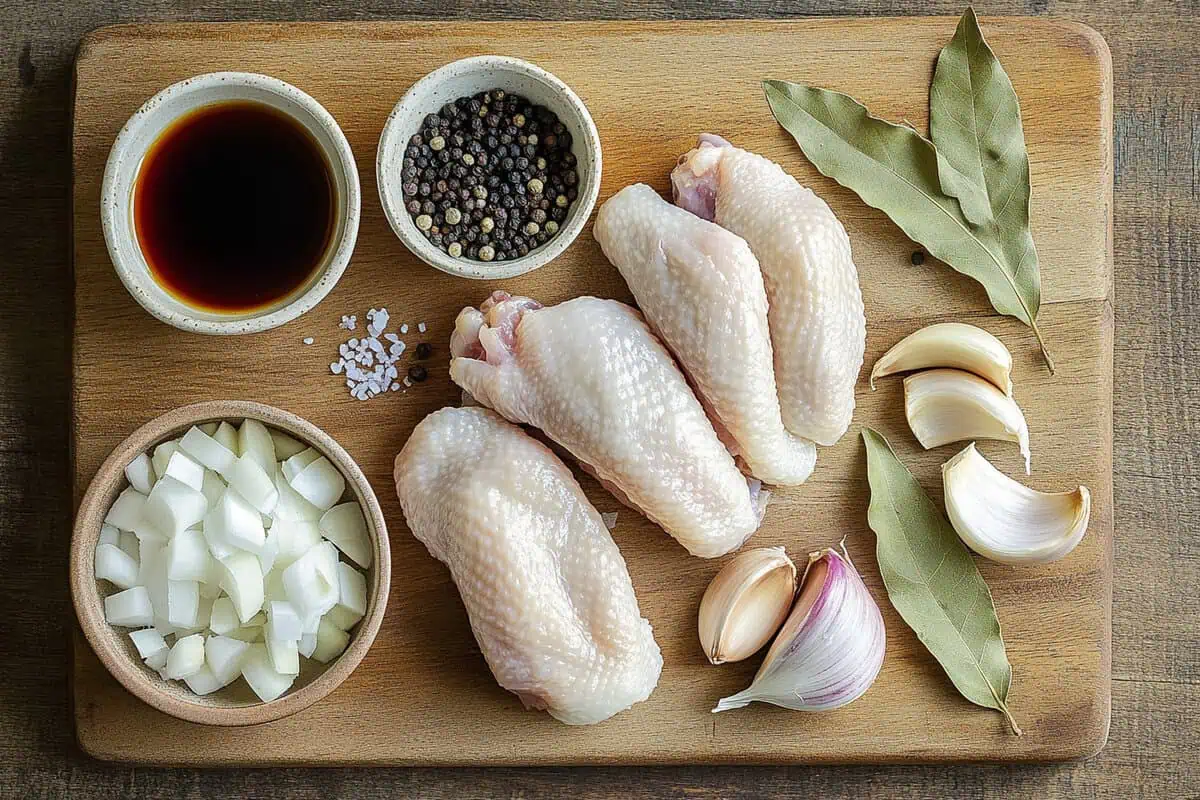
For the Chicken Wings:
- 2 pounds chicken wing drumettes and flats, patted dry
- 1¼ teaspoons kosher salt
- ½ teaspoon black pepper
- 1 small white onion (6 ounces), thinly sliced (about ¾ cup)
- 1 garlic head (2 ounces), cloves separated, peeled, and smashed (about 14 garlic cloves)
- ⅓ cup soy sauce (such as Silver Swan)
- ⅓ cup white vinegar (such as Datu Puti)
- 2 tablespoons neutral cooking oil (such as grapeseed oil)
- 2 to 3 dried bay leaves
- Cooking spray
For the Filipino Pico:
- 4 medium scallions (about 1¾ ounces), thinly sliced (about ½ cup)
- ¼ cup chopped fresh cilantro
- 1 medium serrano chile (unseeded), thinly sliced (about ¼ cup)
- 2 medium tomatoes (about 10 ounces), cored and chopped (about 1½ cups)
- 1½ teaspoons fish sauce (such as Red Boat or Rufina)
- Kosher salt, to taste
For Serving:
- 2 teaspoons fried garlic (such as Maesri)
- Hot cooked white rice
Equipment
- Large ziplock plastic bag for marinating
- Rimmed baking sheet
- Aluminum foil
- Oven-safe wire rack
- Small saucepan
- Fine wire-mesh strainer
- Medium mixing bowl
- Paper towels
- Measuring cups and spoons
- Kitchen thermometer
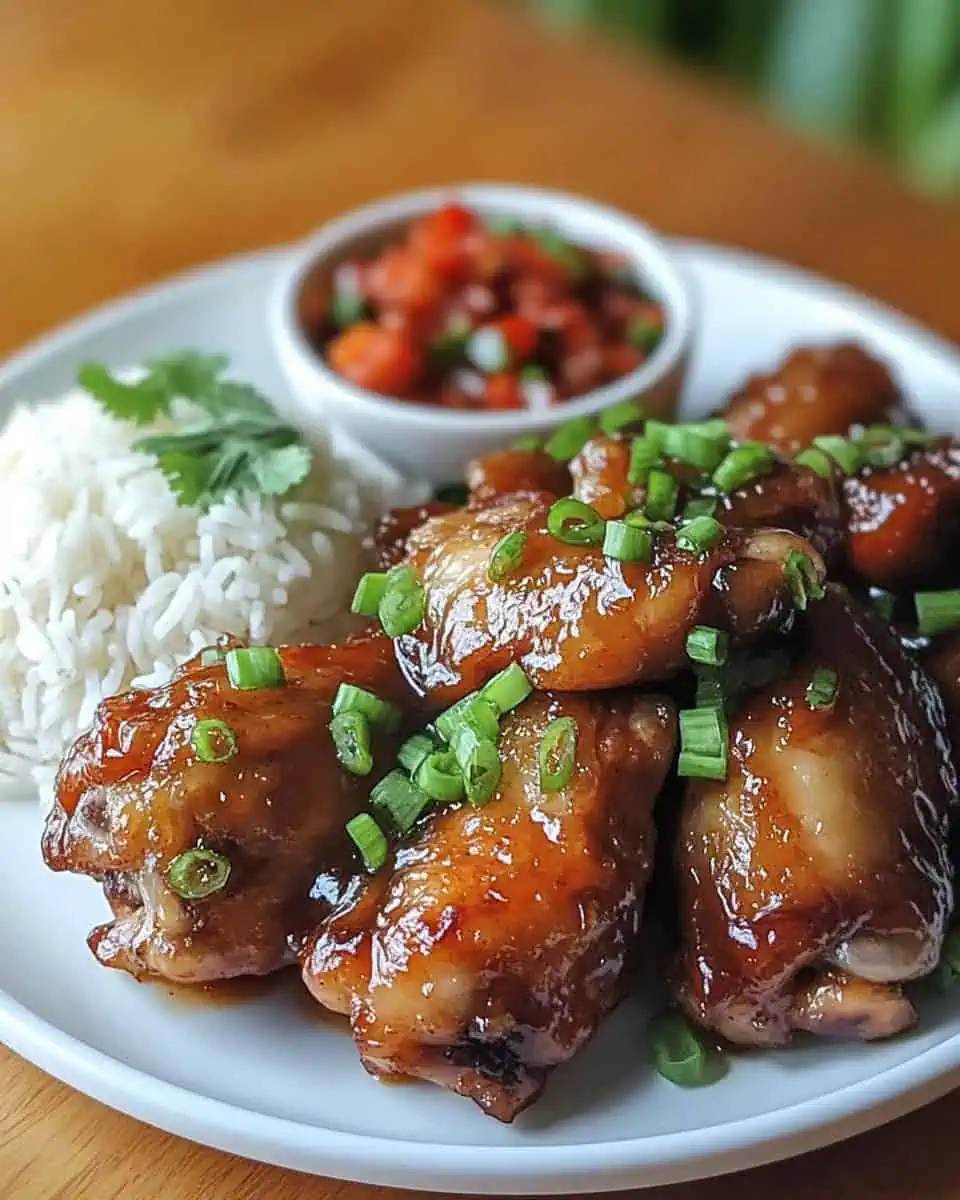
How To Make
- Marinate the chicken wings: Sprinkle chicken all over with salt and pepper. Transfer chicken to a large ziplock plastic bag. Add onion, garlic, soy sauce, vinegar, oil, and bay leaves. Seal bag and toss mixture to evenly combine. Marinate chicken mixture in refrigerator at least 8 hours or up to 1 day.
- Prepare for roasting: Preheat oven to 425°F. Line a rimmed baking sheet with aluminum foil. Lightly coat an oven-safe wire rack with cooking spray and set in baking sheet.
- Arrange wings for roasting: Remove chicken wings from marinade, scraping off excess, and transfer to a paper towel–lined plate; pat dry. Reserve marinade in bag. Arrange wings at least ¼ inch apart on prepared wire rack.
- Roast the wings: Roast in preheated oven until browned and crisp and a thermometer inserted in thickest portion of meat registers at least 165°F, 45 to 50 minutes, flipping wings after 25 minutes.
- Reduce the marinade: Meanwhile, bring reserved marinade to a boil in a small saucepan over medium heat. Boil, stirring occasionally, until liquid is slightly thickened and reduced to about 3 tablespoons, 14 to 16 minutes. Pour mixture through a fine wire-mesh strainer set over a large bowl; discard solids. Set reduced marinade aside.
- Make the Filipino pico: Reserve 1 tablespoon scallions, 1 tablespoon cilantro, and a few slices of serrano for garnish. Stir together tomatoes and remaining scallions, cilantro, and serrano in a medium bowl. Stir in fish sauce and season to taste with salt. Set aside.
- Finish the wings: Add roasted chicken wings to bowl with reduced marinade and toss to coat. Transfer to a platter and garnish with reserved scallions, cilantro, and serrano. Sprinkle evenly with fried garlic.
- Serve: Serve immediately alongside Filipino pico and white rice.

Tips from Lola's Kitchen
- For extra flavor: Let the wings marinate for the full 24 hours. The longer they sit in the marinade, the more flavor they'll absorb.
- For crispier skin: Make sure to pat the wings very dry after removing them from the marinade. Any excess moisture will prevent the skin from crisping properly.
- For even cooking: Don't overcrowd the baking sheet. Make sure the wings are spaced at least ¼ inch apart to allow hot air to circulate around them.
- For maximum flavor: Don't skip reducing the marinade. This concentrated sauce adds an extra punch of flavor when tossed with the cooked wings.
- For perfect wings: Use a thermometer to check that the internal temperature reaches 165°F. This ensures the wings are fully cooked but still juicy.
- For balanced flavor: The Filipino pico adds a fresh, bright counterpoint to the rich wings. Don't skip this accompaniment!
Substitutions
- Chicken parts: If you prefer, you can use this marinade with other chicken parts like thighs or drumsticks. Just adjust the cooking time accordingly.
- Soy sauce: For a gluten-free option, use tamari or coconut aminos instead of traditional soy sauce.
- White vinegar: Apple cider vinegar or rice vinegar can be used, though they will impart a slightly different flavor.
- Serrano chile: Jalapeño can be substituted for less heat, or use Thai bird chiles for more heat.
- Fish sauce: If you don't have fish sauce, you can use a bit more salt in the pico, though you'll miss some of the umami flavor.
- Fried garlic: You can make your own by frying thinly sliced garlic until golden, or use toasted garlic breadcrumbs as an alternative.
Troubleshooting
- Wings not crispy enough? Make sure your oven is fully preheated before adding the wings. Also, check that you've thoroughly patted the wings dry before roasting.
- Marinade too salty? Balance it with a bit more vinegar or a small amount of sugar to round out the flavors.
- Wings burning too quickly? Lower the oven temperature to 400°F and cook for a slightly longer time.
- Sauce not thickening? Continue reducing it over medium heat until it reaches the desired consistency. It should coat the back of a spoon.
- Pico too spicy? Remove the seeds and membranes from the serrano chile before slicing, or use less chile.
Storage & Reheating
- Storage: Store leftover wings in an airtight container in the refrigerator for up to 3 days. Store the pico separately, as it's best when fresh.
- Reheating: For best results, reheat the wings in a 350°F oven for about 10-15 minutes until heated through and the skin crisps up again. Avoid microwaving if possible, as it will make the skin soggy.
- Make ahead: You can marinate the wings up to 24 hours in advance. The reduced sauce can also be made ahead and stored separately in the refrigerator for up to 3 days; gently reheat before tossing with the wings.
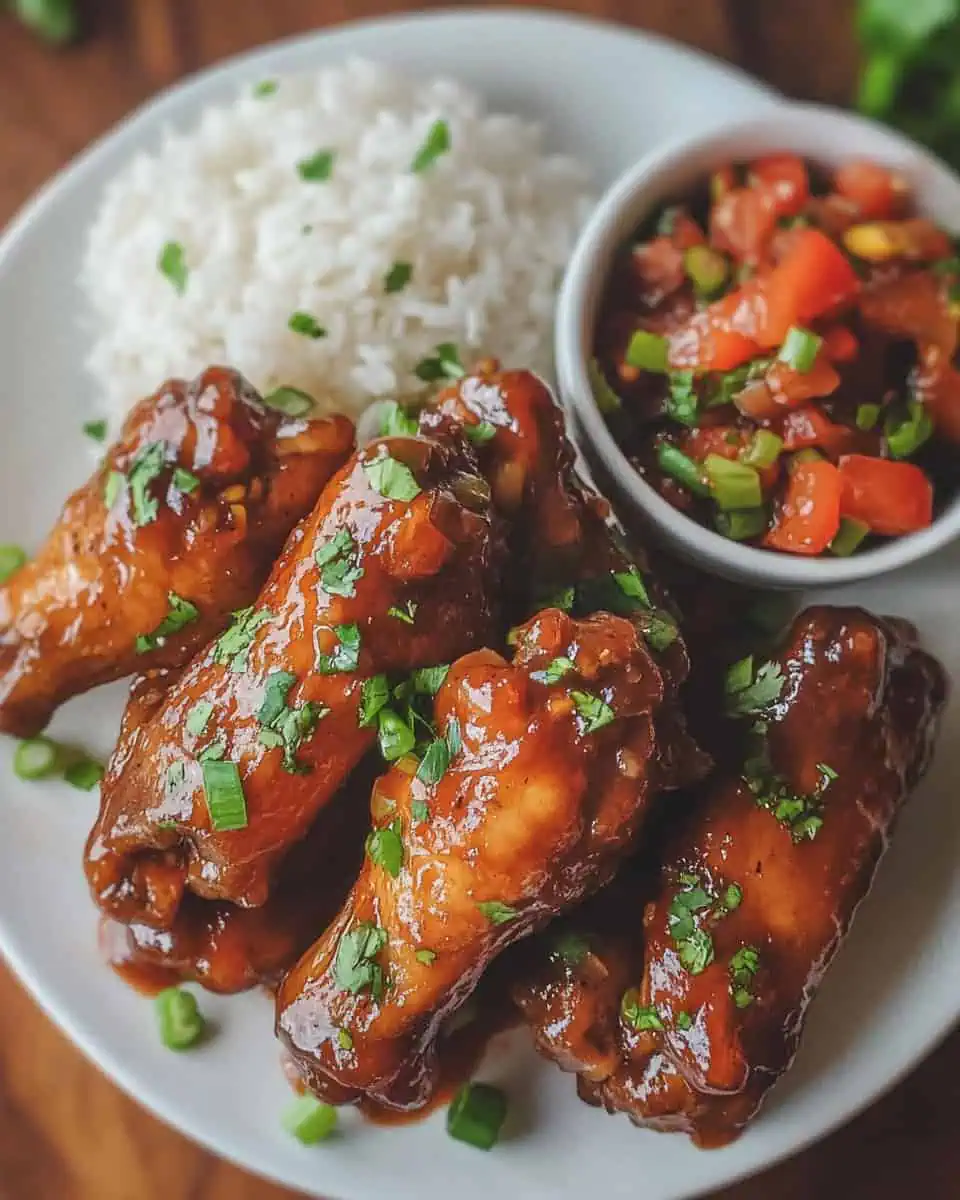
FAQ
Can I grill these wings instead of roasting them?
Yes! Preheat your grill to medium-high heat and grill the wings for about 8-10 minutes per side, or until they reach an internal temperature of 165°F. Then toss with the reduced marinade as directed.
How spicy are these wings?
The wings themselves are not spicy, but have a rich umami flavor from the soy sauce and garlic. The heat comes from the serrano chile in the Filipino pico, which you can adjust to your taste.
Can I freeze the marinated raw wings?
Yes, you can freeze the wings in the marinade for up to 3 months. Thaw completely in the refrigerator before cooking as directed.
What's the difference between Filipino adobo and Mexican adobo?
Filipino adobo uses soy sauce, vinegar, and garlic as its base, while Mexican adobo is a sauce or seasoning made primarily with dried chiles and spices. Though they share a name (due to Spanish colonial influence), they are distinct flavor profiles.
How long can chicken wings sit in this marinade?
These adobo wings need to be marinated in the fridge for at least 8 hours, and you can let them sit for up to a full day (24 hours) before baking.
What else can I serve with these wings?
These wings pair wonderfully with steamed rice and the Filipino pico. You could also serve them with a simple cucumber salad, roasted vegetables, or even Filipino lumpia (spring rolls) for a more substantial meal.
Related
Looking for other recipes like this? Try these:
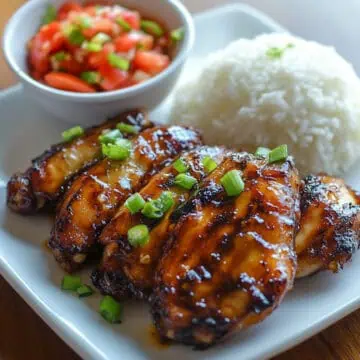
Crispy Adobo Chicken Wings
Ingredients
For the Chicken Wings:
- 2 pounds chicken wing drumettes and flats patted dry
- 1¼ teaspoons kosher salt
- ½ teaspoon black pepper
- 1 small white onion 6 ounces, thinly sliced (about ¾ cup)
- 1 garlic head 2 ounces, cloves separated, peeled, and smashed (about 14 garlic cloves)
- ⅓ cup soy sauce such as Silver Swan
- ⅓ cup white vinegar such as Datu Puti
- 2 tablespoons neutral cooking oil such as grapeseed oil
- 2 to 3 dried bay leaves
- Cooking spray
For the Filipino Pico:
- 4 medium scallions about 1¾ ounces, thinly sliced (about ½ cup)
- ¼ cup chopped fresh cilantro
- 1 medium serrano chile unseeded, thinly sliced (about ¼ cup)
- 2 medium tomatoes about 10 ounces, cored and chopped (about 1½ cups)
- 1½ teaspoons fish sauce such as Red Boat or Rufina
- Kosher salt to taste
For Serving:
- 2 teaspoons fried garlic such as Maesri
- Hot cooked white rice
Instructions
- Marinate the chicken wings: Sprinkle chicken all over with salt and pepper. Transfer chicken to a large ziplock plastic bag. Add onion, garlic, soy sauce, vinegar, oil, and bay leaves. Seal bag and toss mixture to evenly combine. Marinate chicken mixture in refrigerator at least 8 hours or up to 1 day.
- Prepare for roasting: Preheat oven to 425°F. Line a rimmed baking sheet with aluminum foil. Lightly coat an oven-safe wire rack with cooking spray and set in baking sheet.
- Arrange wings for roasting: Remove chicken wings from marinade, scraping off excess, and transfer to a paper towel–lined plate; pat dry. Reserve marinade in bag. Arrange wings at least ¼ inch apart on prepared wire rack.
- Roast the wings: Roast in preheated oven until browned and crisp and a thermometer inserted in thickest portion of meat registers at least 165°F, 45 to 50 minutes, flipping wings after 25 minutes.
- Reduce the marinade: Meanwhile, bring reserved marinade to a boil in a small saucepan over medium heat. Boil, stirring occasionally, until liquid is slightly thickened and reduced to about 3 tablespoons, 14 to 16 minutes. Pour mixture through a fine wire-mesh strainer set over a large bowl; discard solids. Set reduced marinade aside.
- Make the Filipino pico: Reserve 1 tablespoon scallions, 1 tablespoon cilantro, and a few slices of serrano for garnish. Stir together tomatoes and remaining scallions, cilantro, and serrano in a medium bowl. Stir in fish sauce and season to taste with salt. Set aside.
- Finish the wings: Add roasted chicken wings to bowl with reduced marinade and toss to coat. Transfer to a platter and garnish with reserved scallions, cilantro, and serrano. Sprinkle evenly with fried garlic.
- Serve: Serve immediately alongside Filipino pico and white rice.
Tips from Lola's Kitchen
- For extra flavor: Let the wings marinate for the full 24 hours. The longer they sit in the marinade, the more flavor they'll absorb.
- For crispier skin: Make sure to pat the wings very dry after removing them from the marinade. Any excess moisture will prevent the skin from crisping properly.
- For even cooking: Don't overcrowd the baking sheet. Make sure the wings are spaced at least ¼ inch apart to allow hot air to circulate around them.
- For maximum flavor: Don't skip reducing the marinade. This concentrated sauce adds an extra punch of flavor when tossed with the cooked wings.
- For perfect wings: Use a thermometer to check that the internal temperature reaches 165°F. This ensures the wings are fully cooked but still juicy.
- For balanced flavor: The Filipino pico adds a fresh, bright counterpoint to the rich wings. Don't skip this accompaniment!
The Story Behind Adobo Chicken Wings
Adobo Chicken Wings represent the beautiful evolution of Filipino cuisine, bringing together centuries of tradition with modern cooking techniques. As one of the Philippines' most beloved dishes, chicken adobo has a rich history that dates back to the pre-colonial era, when vinegar was used as a natural preservative in the tropical climate.
When Spanish colonizers arrived in the Philippines in the 16th century, they encountered this cooking method and named it "adobo," derived from the Spanish word "adobar," meaning to marinate. Though it shares a name with Spanish and Mexican adobo, Filipino adobo developed independently with its distinctive combination of vinegar, soy sauce, garlic, and bay leaves.
Traditional chicken adobo typically uses bone-in chicken pieces slowly simmered in the marinade until tender, with the sauce reducing to coat the meat. This dish became a staple in Filipino households, with each family developing their own special version passed down through generations.
My version of Adobo Chicken Wings takes this cherished family recipe and adapts it for modern entertaining. Instead of the traditional simmer method, these wings are marinated overnight to infuse that classic adobo flavor, then oven-roasted to achieve the perfect crispy exterior that everyone loves in a great chicken wing.
The inspiration for this fusion came from wanting to introduce more people to Filipino flavors in a familiar format. Chicken wings are universally loved and make the perfect vehicle for showcasing the tangy, savory, and slightly sweet profile of Filipino adobo. By reducing the marinade into a glaze and adding fresh garnishes, these wings maintain authentic flavor while presenting beautifully for parties, game days, or family dinners.
What makes this recipe truly special is how it honors traditional Filipino cooking techniques while creating something new. The overnight marination ensures the wings are flavored all the way to the bone, just as Filipino cooks have done for centuries to develop depth of flavor. The reduction of the marinade follows the traditional "nothing goes to waste" philosophy common in Filipino kitchens.
Whether you're already a fan of Filipino cuisine or trying it for the first time, these Adobo Chicken Wings offer an accessible entry point into one of the world's most underrated culinary traditions. They represent how food evolves across generations while maintaining its cultural soul – crispy, flavorful wings that tell the story of the Philippines with every bite.
So when you serve these wings at your next gathering, you're not just offering delicious food – you're sharing centuries of Filipino culinary history reimagined for your table. And that's what makes cooking so magical: the ability to connect us across time and cultures through the universal language of flavor.
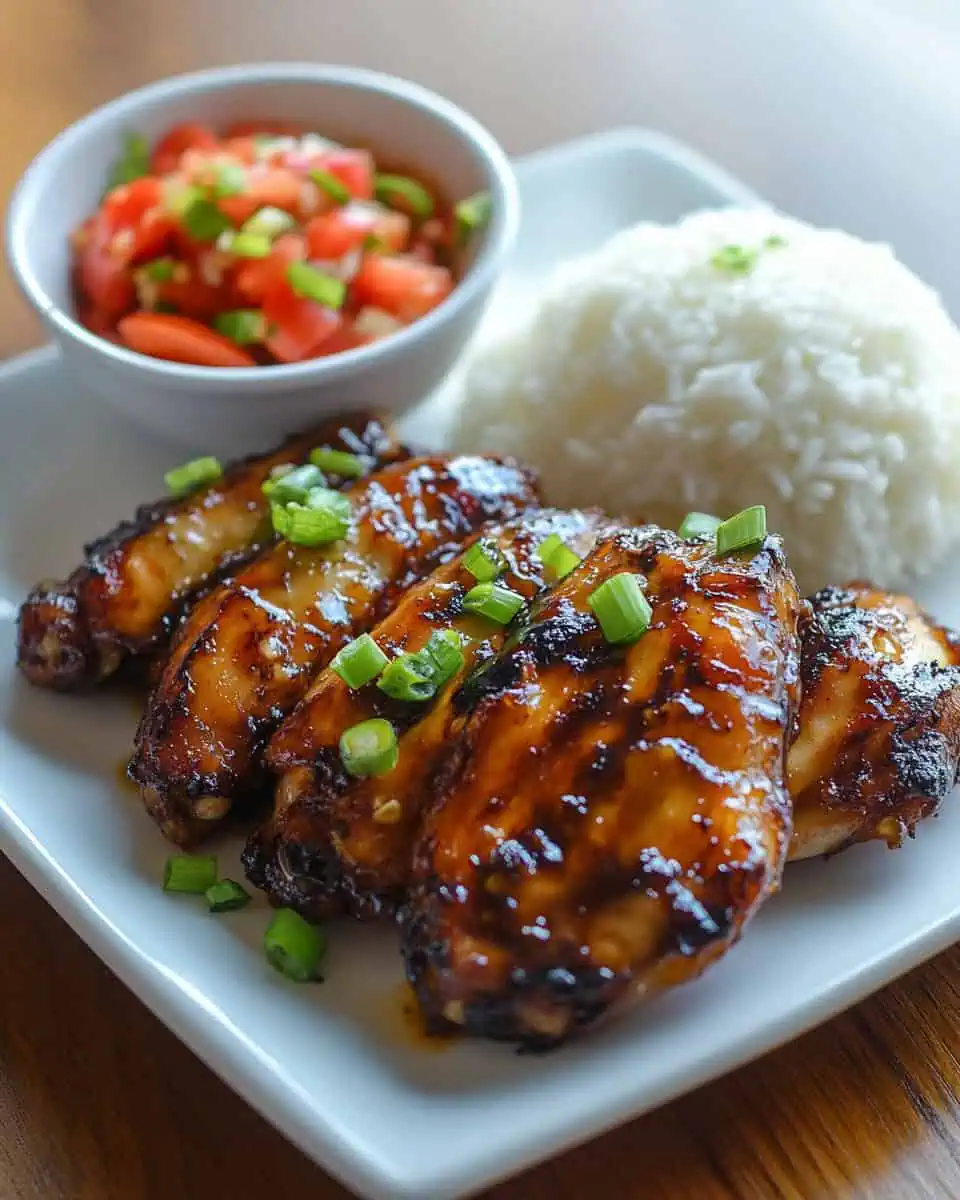

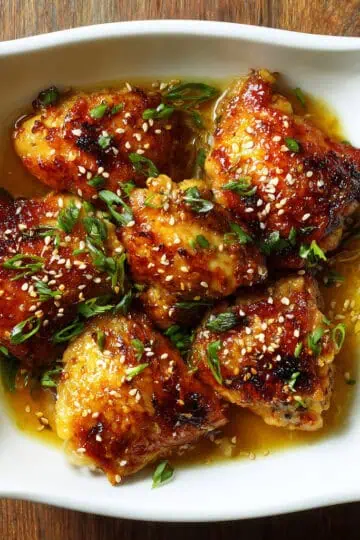
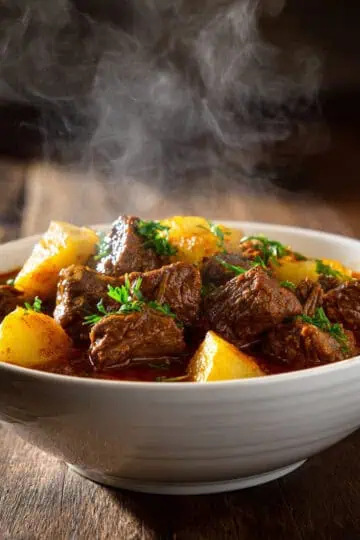

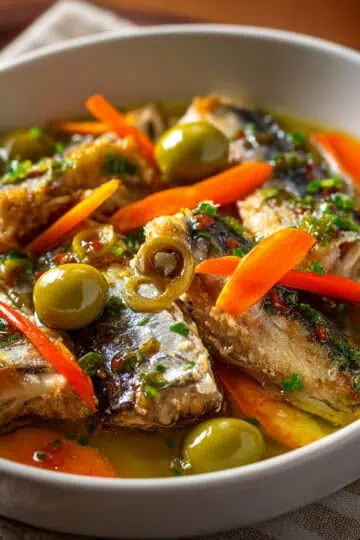
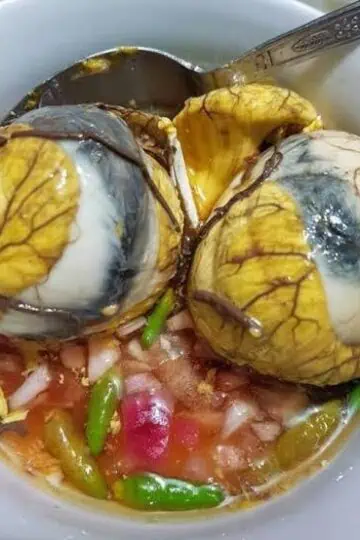
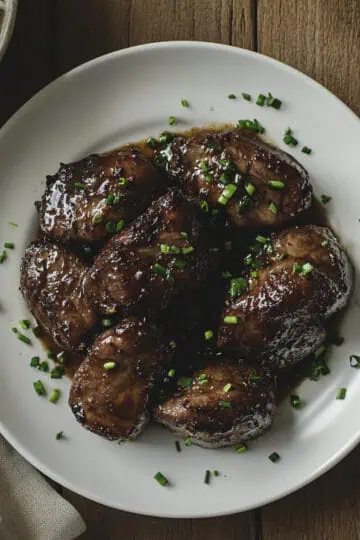


Comments
No Comments